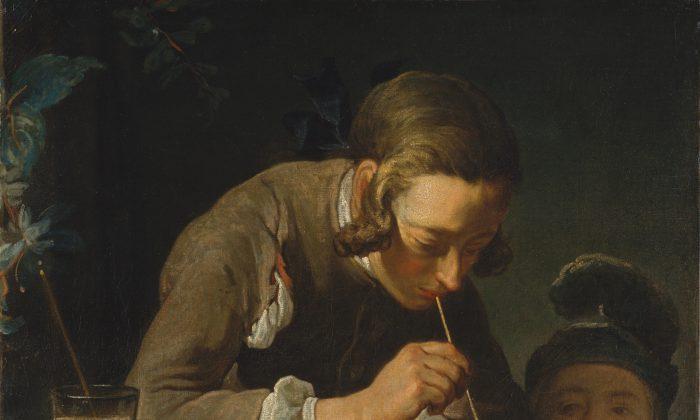NEW YORK—I’m a little miffed that the Metropolitan Museum launched an exhibit in honor of the recent Superbowl, but not for the movie release of The Monuments Men. The film is George Clooney’s take on the group of art experts who saved European masterpieces from Hitler’s looting forces—and the film even features one of the Met’s own, former museum director James Rorimer (the character James Granger is played by Matt Damon).
That said, the museum did put together a self-guided walking tour consisting of some original documents and eleven paintings in the Met’s collection. Nine hang in the European Paintings galleries, with the majority being of Dutch origin. The other two will take you to the 19th- and 20th- Century European Paintings and Sculptures section.

We’ve mapped out the best route to see all eleven paintings. Here you will find the itinerary along with some handy notes about each piece—none of the wall text makes mention of these pieces’ amazing provenance.

Off We Go
Before heading off to the galleries, it’s worth reading the directive that started it all. Dated May 26, 1944, a memo from then-General Dwight D. Eisenhower to various military offices outlines why, amidst an all-consuming war, he felt it was imperative for the U.S. military to protect Europe’s cultural artifacts. I find this document to be deeply moving—Eisenhower’s direct language reveals his sense of urgency, while his reminder to put troops’ lives first reveals his regard for human life.
See this and other documents at the Thomas J. Watson Library, on the first floor to the left of the main staircase.

1. Head up the staircase and to gallery 615 to see Jean Siméon Chardin’s “Soap Bubbles.” This painting belonged to Fritz Mannheimer (1890–1939) of Amsterdam, a high-level Jewish investment banker working in Berlin. He was rumored to be obese, ostentatious, and obnoxious, according to his obituary in Time magazine. After his much-talked about death, his art collection was seized by the Nazis, destined for the planned Führer Museum. The Monuments Men discovered it hidden in the salt mines of Altaussee, Austria, and restituted it to the Netherlands. It was then sold to a New York collector and ultimately to the Met.

2. Oscar (also spelled Oskar) Bondy, a Viennese Jew, was the last owner of “The Adoration of the Magi” by Giovanni di Paolo, before its seizure by the Nazis. He had a large collection containing medieval and Renaissance works as well as Stradivarius violins. Bondy died in New York in 1944. For having been through a war, this painting is in remarkably good shape, save for the warping of the wood. You can find it in gallery 625.
3. Make your way through galleries 626 and 627 and then hang a left for the Dutch collections. In gallery 632 you'll find “A Musician and His Daughter” by Thomas de Keyser. Baron Karl Neuman, a Viennese Jew, was its owner. After it was recovered, it was restituted to his widow, Edith, who gifted it, and many other works, to the Met.
4, 5. In gallery 633 are “The Huis ten Bosch at The Hague and Its Formal Garden (View from the East)” by Jan van der Heyden and “Guardroom with the Deliverance of Saint Peter” by David Teniers the Younger. Both are gifts from Edith Neuman, as is the next piece.
6. “Still Life with Lobster and Fruit” by Abraham van Beyeren hangs in gallery 635. In 1947 the Dutch government loaned 46 recovered paintings to the Met to say thank you for the U.S. government’s efforts. The exhibit “Paintings Looted from Holland: Returned though the Efforts of The Monuments Men” toured 13 U.S. cities.

7. Take a psychological read of “Gamepiece with a Dead Heron” by Jan Weenix, also in gallery 635. It’s not hard to imagine why Hitler might have enjoyed about this painting of game birds taken in a hunt.
8, 9. Jan van Goyen’s “Castle by a River” and “Wide River Landscape” by Philips Koninck in gallery 638 are two beautiful landscapes, also formerly of the Neuman collection.
Now get back through the entrance toward the main stairs and hang a right, down the long walkway to the 19th- and 20th- Century European Paintings and Sculptures galleries.

10. One of Claude Monet’s six views of the Parc Monceau is on view in gallery 818. This sunlit picture was taken out of Alfred Lindenbaum’s safety deposit box at Chase bank, Paris. Then it passed through many hands before it was finally returned to the family. His son, Jacques Lindon, sold it to the Met in 1959.
11. Gustav Klimt’s portrait of “Mäda Primavesi” hung in the home of her father banker Otto Primavesi. In 1928, it was sold or consigned to Neue Galerie in Vienna where it fell into the hands of the Nazis. It is seen in gallery 829.
To learn more about James Rorimer’s wartime and museum career, read the Met’s blog.






